According to the Bureau of Labor Statistics, “median weekly earnings of full-time workers were $876 in the second quarter of 2018. Women had median weekly earnings of $780, or 81.3 percent of the $959 median for men” (2018). This is as of July 17, 2018. This disparity is not of times long ago but a problem occurring in present day. Women who have the same education and skill set are often paid less than their male counterparts. Why is this happening and what can we do to prevent this?
Women working is nothing new. From the beginning of time, women worked to support their families in some capacity. Most jobs women held up until the early 20th century was considered “feminine” jobs such as cleaning, child rearing, cooking, etc. Men were considered the “bread-winners” whereas women stayed at home and take care of the children and spouses. During World War II, women started doing men’s work outside the home due to men being drafted. Many women went into industries such a welding, manufacturing and munitions. Some of the women did jobs directly related to the war such as welding planes and vehicles for the armed services. Women were permitted to do man’s work because the industry had no choice. Even though women were doing a man’s job, doing the same requirements, at the same skill level, women still didn’t get paid close to what a man did doing the same job. According to research done by Ruth Milkman (2016), many supervisors stated that the women they had working for them during the war “out-produced the men in most cases” (p.125). The men came home and resumed the jobs they had before being sent to war leaving women to try to acquire jobs elsewhere.
You can’t put the toothpaste back in the tube. Women got a taste of what they were missing and were beginning to realize that they were being discriminated against. There was starting to become a slow change in the culture of women and their place in society. In 1963, John F. Kennedy signed the Equal Pay Act stating that women and men should be paid the same but in one of the subsets there was a loophole. Taken from the act itself, it states “except where such payment is made pursuant to (i) a seniority system; (ii) a merit system; (iii) a system which measures earnings by quantity or quality of production; or (iv) a differential based on any other factor other than sex” (EOCC). Companies continued to pay men more and had the law to back them up. Management could explain disparities by stating they had seniority or quality of work, whether that was accurate or not.
In 1964, Lyndon Johnson signed into law the Civil Rights Act of 1964 which outlined that people could not be discriminated due to race, sex, color, religion or birth origin. Due to this being passed the creation of the Equal Employment Opportunity Commission (EOCC) was created. The purpose of this commission is to investigate and resolve issues revolving around any violations regarding discriminations and current laws. The EOCC today has the authority to take legal action against companies who conspire to discriminate. It is not the solution but a step in the right direction.
In society, there are norms that are either taught directly and indirectly to people. It seems to be the norm, even today, women are thought of as the caregivers and the home organizers. You look into most homes and you will likely see the woman in the homes making the doctor’s appointments and doing more chores inside the house and the men doing the manly jobs outside the house. It is just what people do naturally without thought. The misalignment of gender roles makes its way into the workplace. In an article in the Washington Post (Kray, 2015), they bring up the issue of salary negotiations as a possible reason for the gender gap. The stereotype of when a man brings up a raise is that he’s a man’s man and good for him for standing up for himself. When a woman requests a raise or promotion in the same style a man does, they are often thought of as pushy and unworkable. The article goes on to point out that when even when women are trained to be better negotiators the societal cultures subjugate the effort (Kray, 2015). Kray also points out the one very important solution to this gender gap is transparency. Companies must make more of an effort to share salaries to public and not create an atmosphere of inequality.
Leslie Stahl, a CBS 60 minutes correspondent, recently sat down with CEO, Mark Benioff, of Salesforce, a tech company. The company employs over 10,000 people and they create billions in revenue every year. The sit-down interview was specifically about the gender gap and how it was discovered at his company. He was advised by his human resource office that she did a simple audit of employees and already with the little of information she had, believed there was a disparity regarding men and women. He felt that he had created an environment of gender equality and was astounded on how it even occurred. He then told the human resource officer to do a full audit and what was discovered was that the gap was widespread. The company started going through each job and person and began to equalize pay. This cost the company over 3 million dollars (2018).
This is where it must start. Nothing will change unless all companies are on board and fight the bias on the inside.





